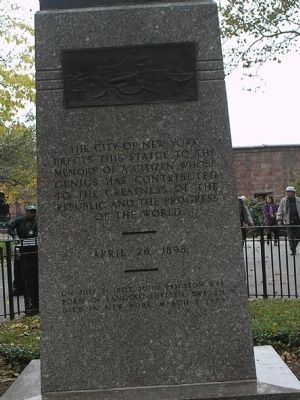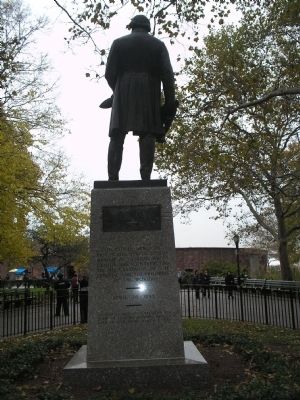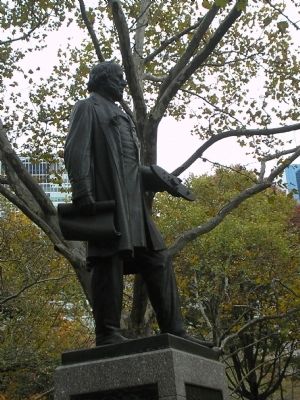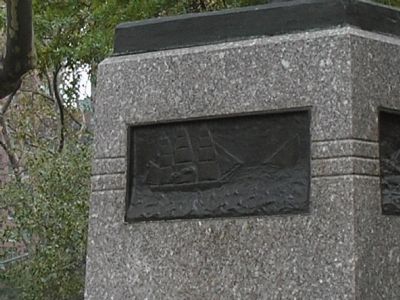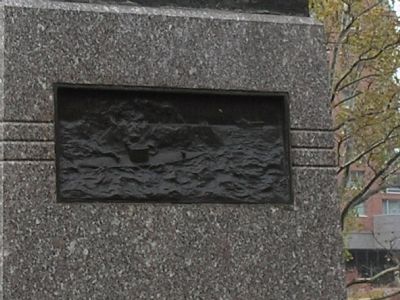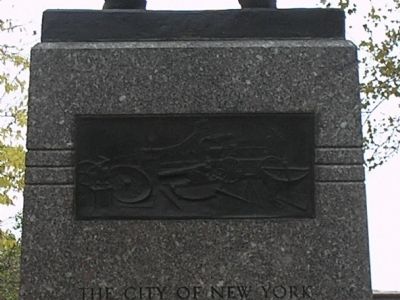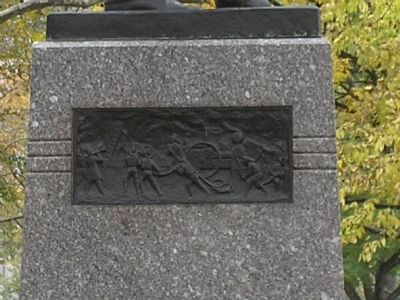Financial District in Manhattan in New York County, New York — The American Northeast (Mid-Atlantic)
John Ericsson
erects this statue to the
memory of a citizen whose
genius has contributed
to the greatness of the
republic and the progress
of the world.
----------
April 26, 1893.
----------
On July 31, 1803, John Ericsson was
Born in Langsbanshytten, Sweden
Died in New York March 8, 1889
Erected 1893 by City of New York.
Topics. This historical marker is listed in this topic list: War, US Civil. A significant historical month for this entry is March 1882.
Location. 40° 42.217′ N, 74° 0.872′ W. Marker is in Manhattan, New York, in New York County. It is in the Financial District. Marker can be reached from State Street, on the right when traveling south. Marker is located in the northeast part of Battery Park. Touch for map. Marker is in this post office area: New York NY 10004, United States of America. Touch for directions.
Other nearby markers. At least 8 other markers are within walking distance of this marker. John Ericsson Statue (here, next to this marker); This Ancient Cannon (within shouting distance of this marker); Fort George (within shouting distance of this marker); Wireless Operators Memorial (within shouting distance of this marker); Netherlands Monument (about 300 feet away, measured in a direct line); Netherlands Memorial (about 300 feet away); Historic Battery Park & Castle Clinton (about 300 feet away); American Merchant Marine (about 300 feet away). Touch for a list and map of all markers in Manhattan.
Related marker. Click here for another marker that is related to this marker. A marker for John Ericsson in Washington, D.C.
Also see . . .
1. The Battle of the Ironclads, 1862. EyeWitness to History.com website. (Submitted on November 25, 2008, by Bill Coughlin of Woodland Park, New Jersey.)
2. The Battery: John Ericsson. The official Parks Department description of the monument. (Submitted on December 12, 2018, by Larry Gertner of New York, New York.)
3. John Ericsson. Wikipedia biography. (Submitted on April 11, 2020, by Larry Gertner of New York, New York.)
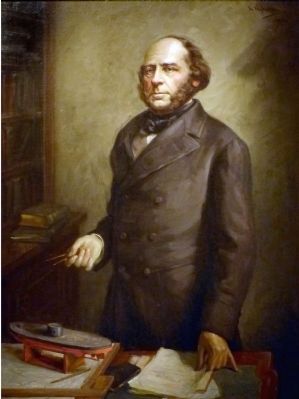
Photographed By Allen C. Browne, February 16, 2015
8. John Ericsson
1803–1889
1803–1889
This 1912 painting by Arvid Frederick Nyholm (after Mathew Brady) hangs in the National Portrait Gallery in Washington D.C.
“Before he came to the United States in 1839, the Swedish-born engineer and inventor John Ericsson revolutionized navigation with his development of the screw propeller, He achieved fame during the Civil War when he designed the ironclad warship Monitor, the federal response to the threat of the Confederate ironclad Virginia (the refitted USS Merrimac) , Ericsson, posing with a model of his ‘tin can on a raft,’ always worked alone and had previously perfected engines for many purposes, including fire engines and a steam locomotive. He later developed the forerunner of the modern naval destroyer. ” — National Portrait Gallery
“Before he came to the United States in 1839, the Swedish-born engineer and inventor John Ericsson revolutionized navigation with his development of the screw propeller, He achieved fame during the Civil War when he designed the ironclad warship Monitor, the federal response to the threat of the Confederate ironclad Virginia (the refitted USS Merrimac) , Ericsson, posing with a model of his ‘tin can on a raft,’ always worked alone and had previously perfected engines for many purposes, including fire engines and a steam locomotive. He later developed the forerunner of the modern naval destroyer. ” — National Portrait Gallery
Credits. This page was last revised on January 31, 2023. It was originally submitted on November 25, 2008, by Bill Coughlin of Woodland Park, New Jersey. This page has been viewed 1,068 times since then and 22 times this year. Last updated on April 3, 2010, by Richard E. Miller of Oxon Hill, Maryland. Photos: 1, 2, 3, 4, 5, 6, 7. submitted on November 25, 2008, by Bill Coughlin of Woodland Park, New Jersey. 8. submitted on March 21, 2015, by Allen C. Browne of Silver Spring, Maryland. • Kevin W. was the editor who published this page.
